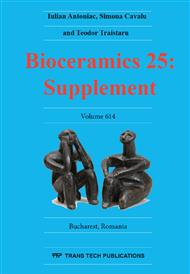p.3
p.7
p.11
p.17
p.22
p.26
p.31
p.35
Bioactivity Assessment of Niobate Apatite
Abstract:
Hydroxyapatite is a bioceramic material of great interest for use as bone substitute because of its similarity with the composition of biological apatite. Cationic and anionic substitutions in the apatite structure have been made in order to optimize the synthesis and accelerate the process of bone repair. In the present study, niobate apatite was synthesized by a patented aqueous precipitation method. The bioactivity of the samples was assessed by X-ray diffraction analyses (XRD), energy dispersive X-ray spectroscopy (EDS) and scanning electron microscopy with field emission gun (FEG-SEM; FEI Quanta FEG 250) in the samples before and after an incubation period in simulated body fluid. The results showed that after 3 days a bone-like apatite coating was formed onto the niobate apatite surface. A peculiar morphology comprised by nanosized wires was also observed on the niobate apatite surface.
Info:
Periodical:
Pages:
3-6
Citation:
Online since:
June 2014
Keywords:
Price:
Сopyright:
© 2014 Trans Tech Publications Ltd. All Rights Reserved
Share:
Citation:


